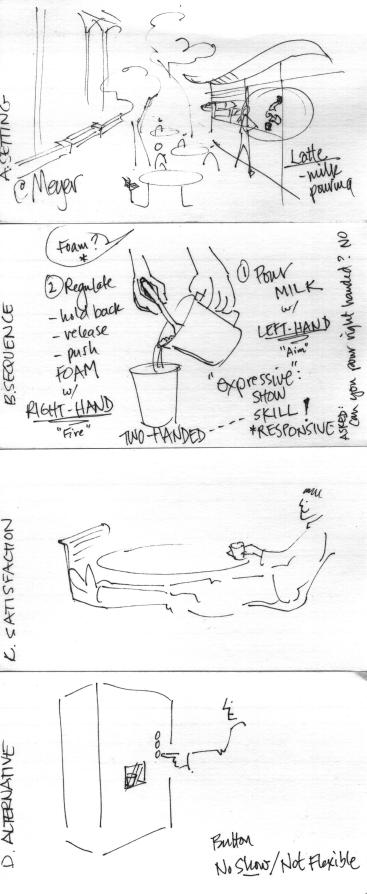DUE MONDAY 10/7
PART 1: Buttons vs. Handles
by Bill Verplank
- One way to distinguish the ways we DO things is with HANDLES or BUTTONS.
- Buttons are discrete, handles continuous. With a button you initiate and let go; with a handle you grab on and contol. Button clicks are more likely symbolic - we string them together. Handles are more analogic - we gesture and indicate.
- Bring to class two sketches (8-1/2 x 11); one of a ``handle one of a ``button".
- Sketch enough of the context so it is clear where and who might use it.
- List the features that make this a good or bad example - what you like or don't.
- Tips:
- You will present these to everyone in the class. Use a Sharpie.
- The drawing should be self-explanatory. Use as few words as possible.
- Make it clear how the user interacts with it. Where are the user's hands?
Part 2 - Expressive Scenarios
 |
- Observe someone doing an "expressive" activity.
- Pay particular attention to the devices or controllers they are using. For example, a musician uses an instrument, a painter uses a brush, a pastry chef uses a icing bag, a sushi chef uses a very sharp knife. Think about alternative controllers and think about how the activity would be more or less expressive. For example, a flute player blows a jet of air over a hole; a whistle or recorder player has the jet formed for him and lacks the expressive "freedom" of a flute player.
- On one page, draw a sequence of sketches and notes to A) establish the setting, B) detail the sequence of actions that you observed, and C) describe the resulting satisfactions. Also, D) include a quick sketch of an alternative controller that might make the actions less expressive but more "efficient". Add some notes. Maybe ask your "artist" what they like about a particular "instrument".
- The goal of this assignment is to ground your ideas in direct observation, to look in detail at what "expressive" means and to begin thinking about what makes controllers more or less "expressive".
- During class Monday morning, we will compare sketches and have a short discussion. In the process, you might have some ideas about a controller that you would like to build for this course.
|
PART 3: Reading
1 - Contexts of Collaborative Musical Experience
http://www.nime.org/proceedings/2003/nime2003_129.pdf
2 - Multi-user Instruments: Models, Examples and Promises
http://www.nime.org/proceedings/2005/nime2005_023.pdf
